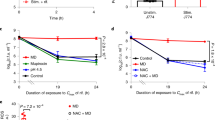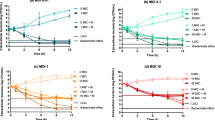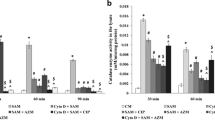Abstract
The present study was performed in order to carefully investigate the interaction of Staphylococcus aureus with murine macrophages and the contribution of catalase and superoxide dismutase in intracellular persistence of Staphylococcus aureus within murine macrophages during in vitro infection. We have reported that Staphylococcus aureus internalized by murine macrophages did not appear to be rapidly killed. Data indicating the contribution of a single catalase and superoxide dismutase in intracellular survival of Staphylococcus aureus were provided using established biochemical assays. The results of the present experiment suggest that the survival of Staphylococcus aureus within phagocytic cells is facilitated by its ability to resist oxidative products. Organisms in the log phase of growth clearly demonstrate a resistance to oxidative products.







Similar content being viewed by others
References
Pailard D, Grellet J, Dubois V, Saux CM, Quentin C (2002) Discrepancy between uptake and intracellular activity of moxifloxacin in a staphylococcus aureus-Human THP-1 monocytic cell model. Antimicrobiol Agents Chemother 46(2):288–293
Lowy FD (1998) Staphylococcus aureus infection. N Eng J Med 339(8):520–532
Silverstein SC, Steinbery TH (1990) Host defense against bacterial and fungal infections. In: Davis BD, Dulbecco R, Eisen HN, Ginsberg HS (eds) Microbiology. J.P Lippincott Company, Philadelphia, pp 485–505
Stor ZG, Tartaglia LA, Farr SB, Ames BN (1990) Bacterial defense against oxidative stress. Trends Genet 6:363–368
Hampton MB, Kettle AJ, Winterbourn CC (1998) Inside the neutrophil phagosome: oxidants myeloperoxidase and bacterial killing. Blood 92:3013–3017
Day WA, Sajecki JL, Pitts TM, Joens LA (2002) Role of catalase in Campylobacter jejuni intracellular survival. Infect Immun 68:6337–6345
Martin SE, Chaven S (1987) Synthesis of catalase in Staphylococcus aureus MF-31. Appl Environ Microbiol 53:1207–1209
Harrington FowlerLP, Henson PM, Wilder MS (1981) Fate of Listeria monocytogenes in resident and activated macrophages. Infect Immun 33:11–20
Bayles KW, Wesson CA, Liou LF, Fox LK, Bohach GA, Trumble WR (1998) Intracellular S. aureus escapes the endosome and reduces apoptosis in epithelial cells. Infect Immun 66:336–342
Balwit JM, Langevelde PV, Vann JM, Proctor RA (1994) Gentamicin resistant menadione and hemin auxotrophic Staphylococcus aureus persist within cultured endothelial cells. J Infect Dis 170:1033–1037
Proctor RA, Balwit JM, Vesga O (1994) Variant subpopulation of Staphylococcus aureus as cause of persistent and recurrent infections. Infect Agents Dis 3:302–312
Yancey RJ, Sanchez MS, Ford CW (1991) Activity of antibiotics against Staphylococcus aureus within polymorphonuclear neutrophils. Eur J Clin Microbiol Infect Dis 10:107–113
Clement MO, Watson SP, Foster SJ (1999) Characterization of the major superoxide dismutase of S.aureus and its role in starvation, survival, stress resistance and pathogenicity. J Bacteriol 181:3898–3903
Hamton MB, Kettle AJ, Winterbourn CC (1996) Involvement of superoxide and myeloperoxidase in oxygen dependent killing of S. aureus by neutrophils. Infect Immun 64:3512–3517
Gresham HD, Lowrance JH, Caver TE, Wilson BS, Cheung AL, Lindberg FP (2000) Survival of Staphylococcus aureus inside neutrophils contribute to infection. J Immunol 164:3713–3722
Beaman L, Beaman BL (1984) The role of oxygen and its derivatives in microbial pathogenesis and host defense. Ann Rev Micobiol 38:27–48
Verdrengh M, Tarkowski A (2000) Role of macrophages in Staphylococcus aureus induced arthritis and sepsis. Arthritis Rheum 43:2276–2282
Anderson JC (1986) Staphylococcus. In: Gyles CL, Thunen CD (eds) Pathogenesis of bacterial infections in animals. Iowa State Univ Press, Ames, p 14
Collins CH, Lyne PM (1976) Microbiological methods, 4th edn. Butterworths, Boston, p 170
Yao L, Berman JW, Stephen MF, Franklin DL (1997) Correlation of histopathologic and bacteriologic changes in experimental murine model of bacteremic Staphylococcus aureus infection. Infect Immun 65:3889–3895
Meltzer MS (1981) In: Adams DO, Edelson PJ, Koren HS (eds) Methods for studying mononuclear phagocytes. Academic Press, New York, p 133
Kahl BC, Goulian M, Wamel W, Herrmann M, Simon SM, Kaplan G, Peters G, Cheung AL (2000) Staphylococcus aureus RN6390 replicates and induces apoptosis in pulmonary epithelial cell line. Infect Immun 68:5385–5392
Nielson SL, Black FT, Storgaard M, Obel N (1995) Evaluation of a method for measurement of intracellular killing of Staphylococcus aureus in human neutrophil granulocytes. APMIS 103:460–468
Barnes AC, Balebona MC, Horne MT, Ellis AE (1999) Superoxide dismutase and catalase in Photobacterium damselae subsp. Piscicida and their roles in resistance to reactive oxygen species. Microbiology 145:483–494
Beauchamp C, Fridovich (1971) Superoxide dismutase: improved assays and an assay applicable to acrylamide gels. Anal Biochem 44:276–287
Woodbury W, Spencer AK, Stahmann MA (1971) An improved procedure using ferricyanide for detecting catalase isozymes. Anal Biochem 44:301–305
Lee JS, Bok SH, Park YB, Lee MK, Choi MS (2003) 4-Hydroxycinnamate lowers plasma and hepatic lipids without changing antioxidant enzyme activities. Ann Nutr Metab 47:144–151
Soop M, Duxbury H, Agwunobi AO, Agwunobi AO, Gibson JM, Hopkins SJ et al (2002) Euglycemic hyperinsulinemia augments the cytokine and endocrine responses to endotoxins in humans. Am J Physiol Endocrinol Metab 282:E1276–E1285
Macay MB, Seral C, Leclercq MP, Tulkens PM, Bambeke VF (2006) Pharmacodynamic evaluation of the intracellular activities of antibiotics against Staphylococcus aureus in a model of THP-1 macrophages. Antimicrob Agents Chemother 50:841–851
Johnston RB Jr, Keele BB Jr, Misra HP, Lehmeyer JE, Webb LS, Bachner RL, Rajagopalan KV (1975) The role of superoxide anion generation in phagocytic bactericidal activity. Studies with normal and chronic granulomatous disease leukocytes. J Clin Invest 55:1357–1360
Sanchez MS, Ford CW, Yancey RJ (1994) Effect of tumor necrosis factor alpha, interleukin 1 beta and antibiotics on the killing of intracellular Staphylococcus aureus. J Dairy Sci 77:1251–1258
Bekker LG, Freeman S, Murray P, Ryffel B, Kaplan G (2001) Tumor necrosis factor alpha controls intracellular mycobacterial growth by both inducible nitric oxide synthase dependent and inducible nitric oxide synthase independent pathways. J Immunol 166:6728–6734
Acknowledgments
This study was carried out with support of an unrestricted research grant from Indian Council of Medical Research (ICMR), New Delhi, Government of India, provided to Dr. Biswadev Bishayi, Senior Lecturer, Department of physiology, University of Calcutta, Kolkata. We are deeply indebted to Prof. (Mrs.) Manjusree Bal, Department of Physiology, University of Calcutta, for supplying us with S. aureus (CMC-524, ICH-629 and ICH-757). We remain thankful to Prof. Sanghamitra Raha, Saha Institute of Nuclear Physics, Kolkata, India, for their kind help and guidance in the in situ staining techniques.
Author information
Authors and Affiliations
Corresponding author
Rights and permissions
About this article
Cite this article
Das, D., Bishayi, B. Contribution of Catalase and Superoxide Dismutase to the Intracellular Survival of Clinical Isolates of Staphylococcus aureus in Murine Macrophages. Indian J Microbiol 50, 375–384 (2010). https://doi.org/10.1007/s12088-011-0063-z
Received:
Accepted:
Published:
Issue Date:
DOI: https://doi.org/10.1007/s12088-011-0063-z




